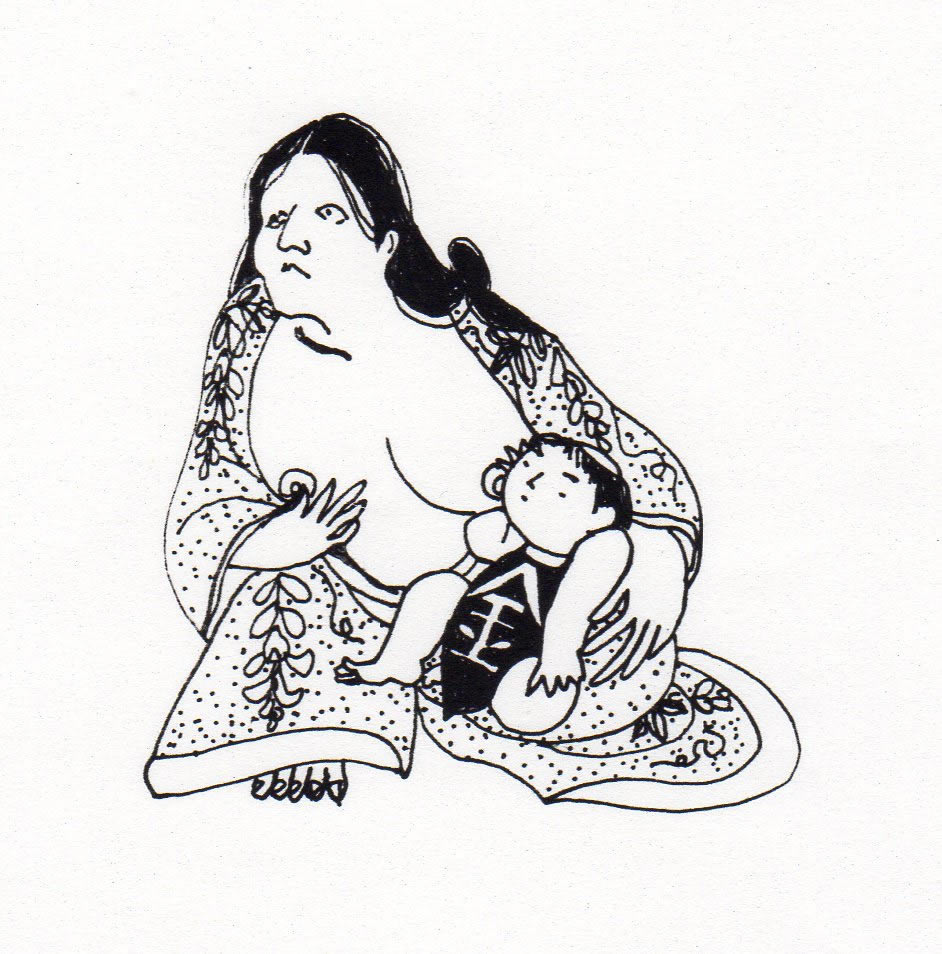|
||
 |
||
1@A painting subject during the Edo period, depicting a legendary mountain woman often accompanied by her child of herculean strength *Kintarou ΰΎY (also called Kaidoumaru φΆΫ). In folk legend, Yamauba is known as a demonic character with supernatural powers who lives deep in the mountains with monkeys and deer, raising her young son Kintarou. A similar character appears in the Noh drama of the same name YAMAUBA RW. In the *nou \ play, the courtesan Hyakuma Yamauba SRW traveling in the mountains of Echigo zγ and Etchuu z (present day Niigata and Toyama prefectures) stops at the house of a local peasant woman. At midnight, she is seen dancing in her real form as a demonic woman. Chikamatsu Monzaemon ίΌεΆqε (1653-1724) wrote the joururi ςΪ play, KOMOCHI YAMAUBA aRW (1712), combining aspects of the noh and legends about the remarkably strong boy. In this play Sakata no Tokiyuki βcs is forced to commit suicide, and his blood, which has the power to inspire the desire for vengeance, is presented to his wife, Yaegiri ͺdΛ. She goes into the mountains, becoming Yamauba, and there raises her son Kaidoumaru, the living memorial of her husband. Kaidoumaru, after coming to the attention of Minamoto no Yorimitsu Ήυ (? -1021), a famous warrior, grows up to become a courageous warrior himself, Sakata no Kintoki βcφ, and avenge his father.
The subject also appeared in illustrated books about ghosts, such as HYAKKIYAGYOU SSιs (1776) in which the figure of a horrible old lady holds the boy Kintarou.
Yamauba is usually represented with long hair hanging down in dishevelled tresses, and dressed in tattered, flimsy clothing. A famous example is the votive tablet *ema Gn done by Nagasawa Rosetsu ·ςεbα (1754-1799) at Itsukushima Jinja ΅_Π in Hiroshima prefecture. Many artists of *ukiyo-e ’G depicted Yamauba, not only as a character in an illustration of dramatic performance shibai-e ΕG, but often as a modern-day beauty, humoring her son. In particular, Kitagawa Utamaro μ½μΜ (1754-1806) portrayed many Yamauba in the guise of beautiful women bijin όl.

Q@A noh mask *noumen \Κ used in the play YAMAUBA and representing an old woman, half demon, who roams the mountains. The enigmatic personality of Yamauba is apparent in the wide variety of masks used to represent the role. The gaunt features, wrinkled brow and pale coloring of the Houshou σΆ school mask, attributed to the 15c carver Tatsuemon ΄Eqε (see *jissaku \μ), presents a realistic portrayal of an old woman wise to suffering and very human. The ruddy, weather-beaten yamauba mask in the Mitsui Oδ Memorial Museum and attributed to the 15c carver Tokuwaka Ώα has a balance of power, wisdom and sensitivity in its strong, muscular cheeks, flashing eyes and fleshy lips. The Kanze Ο’ school mask is a more elfin version of the Mitsui mask, with lighter coloring , more delicate features, but the same open energy and slightly bared teeth. The Kongou ΰ school owns a mask attributed to the 15c carver Shakuzuru Τί that appears demonic with bright vermilion flesh, and close-knit eyebrows hovering over protruding round eyes, yet has abstractly rendered wrinkles lining the cheeks and forehead to suggest old age. Finally the Umewaka ~α branch of the Kanze school owns a yamauba that emphasizes the demonic aspects of the role, being modeled on the serpent mask *ja Φ, with a gaping, leering mouth dominating the lower half, a pointed nose, and large ears. Despite these wide variances, all the yamauba masks share having small, round metallic irises indicating demonic nature, and all but the Umewaka mask share the representation of hair and eyebrows with alternating lines of white and black, typifying an old woman.
@
(C)2001 Japanese Architecture and Art Net Users System.@No reproduction or republication without written permission.
fΪΜeLXgEΚ^ECXgΘΗASΔΜRecΜ³f‘»E]ΪπΦΆά·B

